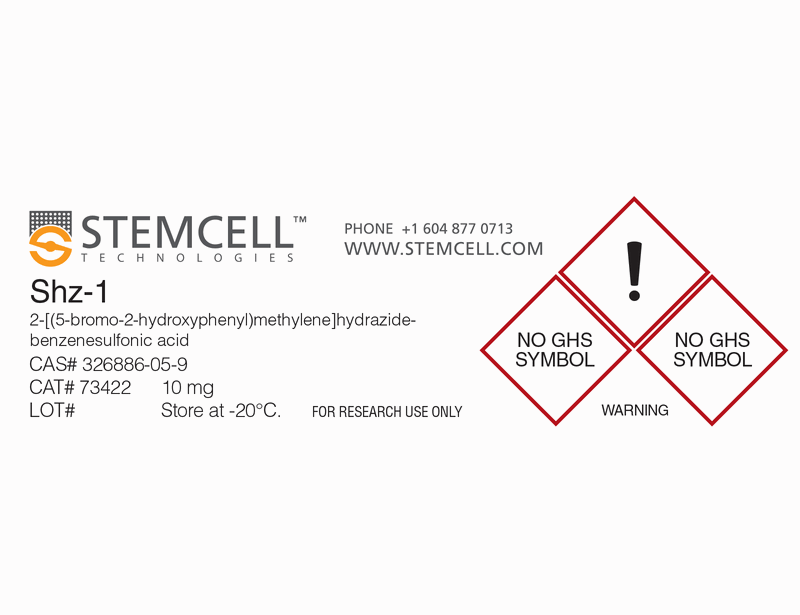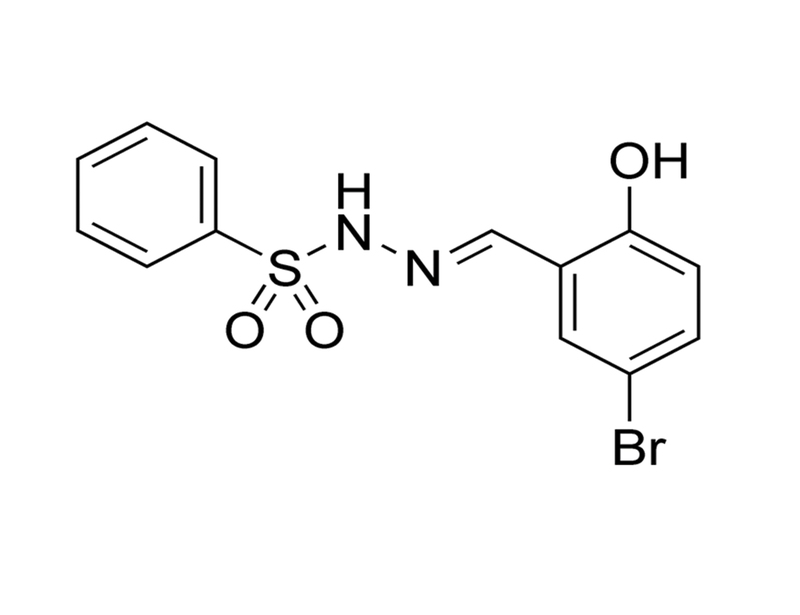概要
Shz-1 is a cell-permeable, sulphonyl hydrazone (Shz) compound that activates cardiac differentiation through induction of genes such as Nkx2.5 (Sadek et al.).
DIFFERENTIATION
· Promotes cardiac differentiation in mouse induced pluripotent stem cells (Quattrocelli et al.).
·Induces cardiac differentiation of human mobilized peripheral blood mononuclear cells; these cells enhance myocardial regenerative repair when injected in a cryo-injured rat heart model (Sadek et al.).
DIFFERENTIATION
· Promotes cardiac differentiation in mouse induced pluripotent stem cells (Quattrocelli et al.).
·Induces cardiac differentiation of human mobilized peripheral blood mononuclear cells; these cells enhance myocardial regenerative repair when injected in a cryo-injured rat heart model (Sadek et al.).
技术资料
| Document Type | 产品名称 | Catalog # | Lot # | 语言 |
|---|---|---|---|---|
| Product Information Sheet | Shz-1 | 73422 | All | English |
| Safety Data Sheet | Shz-1 | 73422 | All | English |
数据及文献
Publications (2)
Journal of cellular biochemistry 2011
Synthetic sulfonyl-hydrazone-1 positively regulates cardiomyogenic microRNA expression and cardiomyocyte differentiation of induced pluripotent stem cells.
Abstract
Abstract
Induced pluripotent stem cells (iPSCs) are obtained from adult cells through overexpression of pluripotency factors. iPSCs share many features with embryonic stem cells (ESCs), circumventing ethical issues, and, noteworthy, match donor's genotype. iPSCs represent therefore a valuable tool for regenerative medicine. Cardiac differentiation of ESCs can be enhanced via microRNAs (miRNAs) and small chemical compounds, which probably act as chromatin remodelers. Cardiomyogenic potential of iPSCs is currently intensely investigated for cell therapy or in vitro drug screening and disease modeling. However, influences of small compounds on iPSC-related cardiomyogenesis have not yet been investigated in details. Here, we compared the effects of two small molecules, bis-peroxo-vanadium (bpV) and sulfonyl-hydrazone-1 (SHZ) at varying concentrations, during cardiac differentiation of murine iPSCs. SHZ (5 µM) enhanced specific marker expression and cardiomyocyte yield, without loss of cell viability. In contrast, bpV showed negligible effects on cardiac differentiation rate and appeared to induce Casp3-dependent apoptosis in differentiating iPSCs. Furthermore, SHZ-treated iPSCs were able to increase beating foci rate and upregulate early and late cardiomyogenic miRNA expression (miR-1, miR-133a, and miR-208a). Thus, our results demonstrate that small chemical compounds, such as SHZ, can constitute a novel and clinically feasible strategy to improve iPSC-derived cardiac differentiation.
Proceedings of the National Academy of Sciences of the United States of America 2008
Cardiogenic small molecules that enhance myocardial repair by stem cells.
Abstract
Abstract
The clinical success of stem cell therapy for myocardial repair hinges on a better understanding of cardiac fate mechanisms. We have identified small molecules involved in cardiac fate by screening a chemical library for activators of the signature gene Nkx2.5, using a luciferase knockin bacterial artificial chromosome (BAC) in mouse P19CL6 pluripotent stem cells. We describe a family of sulfonyl-hydrazone (Shz) small molecules that can trigger cardiac mRNA and protein expression in a variety of embryonic and adult stem/progenitor cells, including human mobilized peripheral blood mononuclear cells (M-PBMCs). Small-molecule-enhanced M-PBMCs engrafted into the rat heart in proximity to an experimental injury improved cardiac function better than control cells. Recovery of cardiac function correlated with persistence of viable human cells, expressing human-specific cardiac mRNAs and proteins. Shz small molecules are promising starting points for drugs to promote myocardial repair/regeneration by activating cardiac differentiation in M-PBMCs.

 网站首页
网站首页




